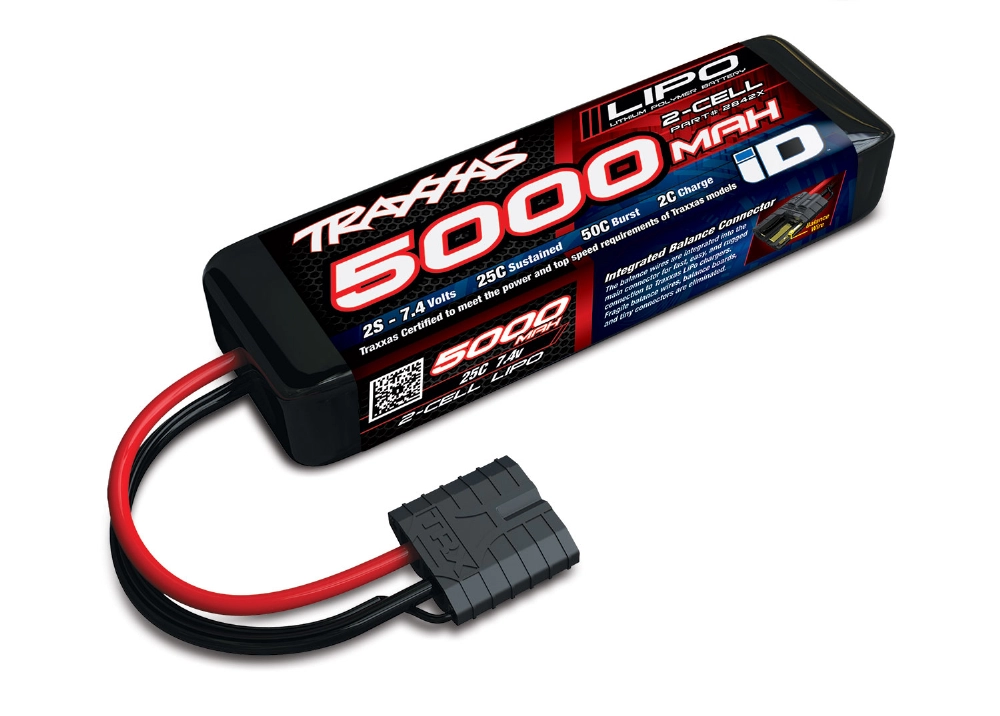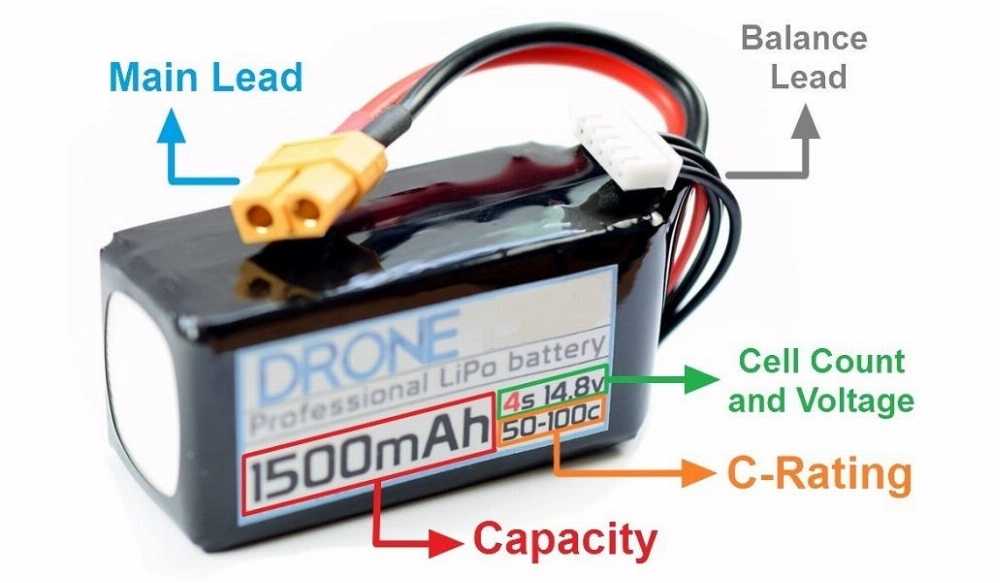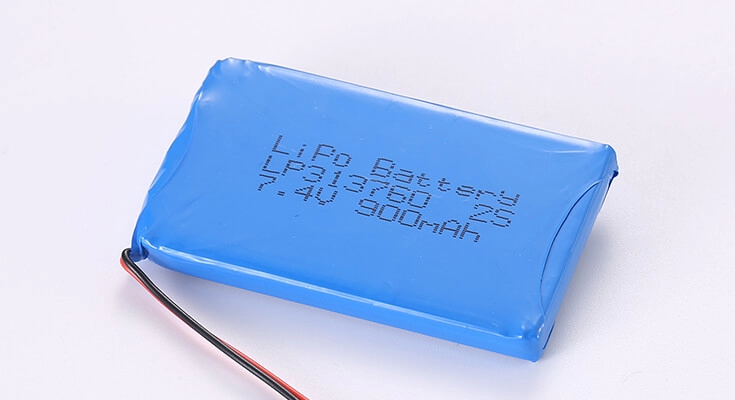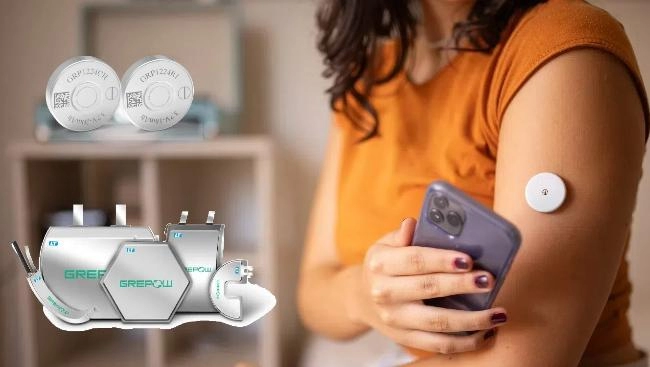Part 1: Introduction to 4S Lipo Batteries
4S Lipo batteries have gained significant popularity across various industries due to their high energy density, lightweight design, and stable performance. These batteries, composed of lithium polymer cells, are commonly used in remote control hobbies, drones, and electric vehicles. Understanding the core characteristics and functionalities of 4S Lipo batteries can significantly enhance their usage and extend their lifespan.
What is a 4S Lipo Battery?
A 4S Lipo battery consists of four lithium polymer cells connected in series. Each cell typically has a nominal voltage of 3.7 volts, making the nominal voltage of the entire 4S configuration 14.8 volts in total. However, this voltage can differ:
- Fully Charged: Approximately 16.8 volts (4.2 volts per cell).
- Fully Discharged: Approximately 12 to 13 volts (or 3.0 to 3.25 volts per cell).
Key Features
Users looking to maximize the performance of Lipo batteries must understand their key features.
- High Energy Density: Lipo batteries offer an excellent balance between energy and weight, enabling devices to operate longer without adding excessive bulk.
- C-Rating (C-rate, Discharge Rate): This indicates the maximum safe rate at which the battery can discharge. For example, a 30C battery can discharge at a rate 30 times its capacity.
- Voltage Stability: Lipo batteries maintain a stable voltage level, providing a consistent power supply crucial for smooth operation.
- Customizability: Available in various configurations and capacities to meet specific power needs and constraints, making them highly versatile.
Safety Precautions
Despite the numerous advantages of 4S Lipo batteries, careful handling is essential for safety:
- Charging: Always use a balance charger specifically designed for Lipo batteries. Overcharging can lead to fire or explosion.
- Storage: Store batteries in a cool, dry place away from flammable materials. It is recommended to use a Lipo safe bag or container for added safety.
- Usage: Never over-discharge the batteries, as doing so can cause irreversible damage to the cells and may void the warranty.
Applications
4S Lipo batteries are widely used in various applications, including:
- Aerial Drones: Providing longer flight times and greater power output.
- Remote Control Cars and Boats: Offering rapid acceleration and high speeds.
- Electric Bicycles and Scooters: Delivering reliable and extended riding times.
- Portable Electronics: Ideal for various gadgets due to their compact size and impressive capacity.
With this foundational knowledge, users can effectively and safely utilize the full potential of 4S Lipo batteries.
Part 2: Understanding Lipo Battery Ratings
To fully utilize 4S Lipo batteries, understanding their ratings is crucial. These ratings dictate the battery’s performance, safety, and compatibility with specific applications.
1. Voltage Ratings
- Nominal Voltage: In Lipo batteries, the nominal voltage per cell is typically 3.7 volts. Therefore, a 4S (4-cell) Lipo battery has a nominal voltage of 14.8 volts (3.7V x 4).
- Fully Charged Voltage: When fully charged, each cell can reach 4.2 volts, making the fully charged voltage of a 4S Lipo battery 16.8 volts (4.2V x 4).
- Safe Discharge Voltage: It is recommended not to discharge Lipo cells below 3.0 volts to prevent damage. For a 4S Lipo battery, the safe discharge voltage should not go below 12 volts (3.0V x 4).
2. Capacity Rating
Measured in milliampere-hours (mAh), this rating indicates how much charge the battery can store. A higher capacity (e.g., 5000mAh) generally provides longer run times than a lower capacity (e.g., 2200mAh) in similar applications. Users must balance the trade-offs between capacity, weight, and size, especially in aerospace or mobile robotics applications.
3. Discharge Rate (C-Rating)
The C-Rating specifies the maximum continuous discharge rate that the battery can safely handle. For instance, a 30C 2200mAh Lipo battery can continuously discharge at a rate of 66 amps (A) (30 x 2.2). Burst discharge rates are typically higher than continuous rates but can only be sustained for short periods (usually a few seconds).
4. Configuration
The configuration determines the battery’s voltage, capacity, and current capabilities, making it essential to choose the right one for your specific needs.
For more details on the differences between battery cells, modules, and battery packs, visit this link.
Part 3: Reasons for Choosing a 4S LiPo Battery
For electronics enthusiasts and professionals, understanding the advantages of choosing a 4S LiPo (Lithium Polymer) battery is essential, especially in applications such as remote-controlled (RC) vehicles, drones, and other high-power devices.
Enhanced Performance
A 4S LiPo battery, consisting of four cells in series, provides a nominal voltage of 14.8V, enabling higher power output and performance compared to batteries with fewer cells. The increased voltage offers:
- Increased Speed: Enables faster speeds for RC cars, drones, and boats.
- Greater Thrust: Improves motor efficiency for flight devices, resulting in greater thrust.
Power-to-Weight Ratio
LiPo batteries are known for their excellent power-to-weight ratio, and the 4S configuration maintains this balance. This makes them ideal for applications where weight is critical. Benefits include:
- Longer Flight Times: Drones can stay airborne longer without sacrificing performance.
- Improved Handling: Lightweight design improves the handling of RC vehicles.
Charging Efficiency
4S LiPo batteries are designed to manage high discharge rates and support efficient charging. Some key benefits are:
- Quick Charging: Shorter charging cycles reduce downtime.
- Stable Discharge Rate: Maintains a consistent voltage output, even under high loads, enabling reliable performance.
Durability and Longevity
4S LiPo batteries are designed to withstand numerous charge and discharge cycles, offering long life and sustained performance. Key features that contribute to extended battery life include:
- Robust Construction: Reduces the risk of physical damage, such as swelling.
- Advanced Chemistry: Ensures minimal capacity loss over time, providing long-term usability.
Compatibility
4S LiPo batteries are widely compatible with various devices, offering broad applicability. This includes:
- Wide Applicability: Versatile and suitable for various applications, from high-performance drones to RC vehicles.
- Modularity: Suitable for custom setups requiring specific power and size configurations.
Key Considerations
When using 4S LiPo batteries, certain precautions should be considered:
- Safety: Proper handling and storage are essential to avoid hazards such as fire or explosion.
- Maintenance: Regular checks for swelling, voltage levels, and discharge rates are crucial for prolonging battery life.
Choosing a 4S LiPo battery offers significant advantages in performance, efficiency, and versatility, making it ideal for high-performance applications.
Part 4: Common Applications of 4S LiPo Batteries
4S LiPo batteries are widely used across various industries due to their efficiency, high power output, and versatility. Here are common applications where these batteries are utilized for their unique capabilities.
Hobbyist Drones and Racing Quadcopters
- Speed and Agility: Racing quadcopters (FPV drones) require high power for rapid maneuvers. The increased voltage from 4S LiPo batteries provides the speed and agility needed for competitive flying.
- Flight Time: These batteries offer a balanced compromise between extended flight time and high performance, making them ideal for both recreational and professional drone flying.
- Weight Management: The power-to-weight ratio of 4S LiPo batteries is crucial in drone design, helping to provide a lightweight yet powerful solution for optimal performance.
4S LiPo batteries are a trusted power source for drones and RC vehicles, offering an optimal balance of performance, efficiency, and durability for demanding applications.
4S LiPo Batteries: Applications and Important Considerations
Applications of 4S LiPo Batteries
Remote Control Vehicles
- RC Cars and Trucks: 4S LiPo batteries provide an ideal power output for high-performance RC cars and trucks, enabling faster acceleration and higher top speeds.
- Boats: In RC boats, these batteries deliver the thrust needed for rapid movement on the water, enhancing the racing experience.
- Endurance: 4S LiPo batteries support longer run times, making them well-suited for endurance-based RC activities.
Electric Flight
- Model Airplanes: 4S LiPo batteries are commonly used in electric-powered model airplanes, providing the energy needed for sustained and powerful flights.
- Helicopters: For electric helicopters, these batteries power advanced aerobatics and stable hovering.
- Gliders: In electric gliders, 4S LiPo batteries offer extended flight times and reliable performance during critical phases like take-off and climbing.
Robotics and DIY Projects
- Educational Robots: In educational settings, robots powered by 4S LiPo batteries can perform more complex tasks, helping students understand advanced robotics concepts.
- DIY Electronics: Hobbyists and makers frequently use these batteries in DIY electronics projects due to their compact size and consistent power output.
- Prototype Design: Engineers and developers rely on 4S LiPo batteries to prototype new devices, as they provide a convenient and powerful energy source.
Professional Uses
- Surveying Drones: Professional surveying and mapping drones use 4S LiPo batteries for longer flight times and efficient power delivery.
- Aerial Photography: These batteries support heavy payloads, such as cameras and stabilizers, ensuring smooth and sustained aerial operations.
- Industrial Applications: From inspection drones to automated systems, various industrial applications rely on the robustness and energy density of 4S LiPo batteries.
By exploring these applications, users can fully appreciate the versatility and powerful performance of 4S LiPo batteries across various fields.
Selecting the Right 4S LiPo Battery for Your Needs
When choosing the ideal 4S LiPo battery, several key factors should be considered to ensure optimal performance and long-term reliability. Here are key considerations to keep in mind:
Capacity and Discharge Rate
- Capacity: Measured in milliampere-hours (mAh), a higher capacity translates to longer run times. A higher capacity battery is advisable for extended usage.
- Discharge Rate: The “C” rating indicates how quickly the battery can release its power. High-demand applications like racing drones often require batteries with high C ratings, typically between 50C and 100C or higher.
Voltage Compatibility
- Ensure that the 4S (four-cell) configuration, which provides a nominal voltage of 14.8V, matches the voltage requirements of your device. Ensuring compatibility is crucial for both safety and performance.
Weight Considerations
- Heavier batteries tend to offer higher capacity but may impact performance, particularly in aerial applications where reduced weight can significantly improve agility and flight performance.
Connector Type
- Battery connectors, such as XT60, EC5, and Deans, should match the power input of your device. The correct connector ensures minimal resistance and a secure connection.
Size and Fit
- Check the physical dimensions of the battery to ensure it fits securely in your device’s battery compartment. Comparing available space and battery dimensions is crucial to avoid installation issues.
Brand and Quality
- Opt for reputable brands known for their reliability, better performance, and longer lifespan. Choosing a high-quality battery alleviates concerns about durability and safety.
Price and Budget
- Consider the balance between the required specifications and your budget. While premium batteries offer superior performance, they come at a higher price. Evaluating based on your needs and budget will help you make an informed choice.
Part 5: Choosing the Right 4S LiPo Battery
When selecting a 4S LiPo battery for your device, several key factors must be considered to ensure the battery meets your requirements, performs reliably, and is safe to use.
1. Battery Capacity
Battery capacity is a critical factor that affects performance and runtime. It is typically measured in milliampere-hours (mAh) and determines how much energy the battery can store. Higher capacity means longer runtime, but it also means a larger and heavier battery.
- Choose Based on Application: Select a battery with sufficient capacity to meet the demands of your device while balancing weight and size.
- Consider C-Ratings: The C-rating indicates the discharge rate of the battery. A higher C-rating allows the battery to deliver more power, which is essential for high-performance applications.
2. Voltage
Voltage directly affects the battery’s performance. For a 4S LiPo battery, the voltage is 14.8V (nominal), and this may vary slightly based on the battery’s charge level.
- Ensure Compatibility: Ensure voltage compatibility with your device. Higher voltage can improve performance but may damage components if incompatible.
3. Discharge Rate
The discharge rate, denoted by the C-rating, is crucial for understanding how much power the battery can deliver to your device.
- Select a Discharge Rate Appropriate for Your Device: Choose a battery with a discharge rate suitable for your device’s current and power requirements. The higher the C-rating, the more power it can deliver, but excessively high discharge rates can shorten the battery’s lifespan.
4. Battery Size and Weight
The physical dimensions and weight of the battery are important, especially in drones, RC vehicles, or portable devices where space and weight are limited.
- Consider Compactness: Consider the battery’s size and weight relative to the available space in your device and its ability to maintain performance without being too bulky.
5. Cost-Effectiveness
Cost-effectiveness is an important consideration, especially if the battery will be used frequently.
- Long-Term Cost Savings: Consider the cost relative to battery life, frequency of use, and the energy demands of your device. A high-quality battery may have a higher upfront cost but can save money in the long run due to longer life and better performance.
6. Usage Environment
The environment in which the battery will be used can affect its performance and lifespan. Extreme temperatures, humidity, or other harsh conditions can reduce efficiency.
- Choose Based on Operating Environment: Select a battery designed for the environment in which it will be used, ensuring it can handle extreme temperatures, humidity, or other factors that might cause aging.
7. Charging Specifications
Different LiPo batteries have different charging requirements. Some batteries support fast charging, but only with specific chargers.
- Verify Compatibility: Always verify the recommended charging specifications, including maximum charge rate and charger type. Fast charging can be convenient but should be done with the correct charger to avoid damage.
8. Customer Reviews and Ratings
Reading customer reviews can provide valuable insights into the real-world performance of the battery. Feedback from other users can reveal any issues with reliability, longevity, and performance under various conditions.
- Conduct Thorough Research Before Buying: Before making a purchase, look for reviews that mention battery life, charging times, and overall satisfaction with performance.
By carefully evaluating these factors, you can select a 4S LiPo battery that meets your needs and ensures high performance and safety.
Part 6: 4S LiPo Battery Safety Precautions
Handling 4S LiPo batteries requires strict adherence to safety measures to avoid potential hazards such as fire, explosion, or personal injury. The following guidelines outline essential safety precautions:
1. Pre-Use Inspection
Before using a 4S LiPo battery, inspect it for any physical damage or irregularities.
- Inspect for Damage: Look for signs of swelling, punctures, or frayed wires. Do not use a battery that shows any signs of damage.
2. Proper Charging Practices
Charging LiPo batteries requires careful attention to prevent accidents.
- Always Use the Correct Charger: Always use a LiPo balance charger designed specifically for 4S batteries.
- Never Leave Batteries Unattended While Charging: Never leave batteries unattended while charging, especially overnight.
- Adhere to Charging Limits: Follow the manufacturer’s recommended voltage and current limits to avoid overcharging, which can lead to hazardous situations.
3. Storage Guidelines
Proper storage of LiPo batteries is crucial for maintaining safety and performance.
- Store Under Safe Conditions: Store batteries in a cool, dry place, preferably in a fireproof container or LiPo safe bag.
- Storage Charge Level: Avoid storing batteries fully charged or fully discharged. Store them at around 50-60% charge to prevent damage.
4. Handling and Usage
Handling LiPo batteries correctly reduces the risk of accidents.
- Avoid Extreme Conditions: Keep batteries away from extreme temperatures, direct sunlight, or moisture.
- Handle Carefully: Never puncture, incinerate, or subject the battery to excessive force. Ensure the battery is securely mounted to prevent damage.
5. Disposal
LiPo batteries are hazardous waste and must be disposed of properly.
- Never Dispose of Improperly: Never dispose of LiPo batteries in regular trash. Follow local regulations for safe disposal and use designated recycling centers where available.
6. Accident Response
Quick action can prevent serious incidents if a battery malfunctions.
- Ensure Personal Safety First: If a battery starts smoking, hissing, or showing signs of swelling, move it to a fireproof area and monitor it from a safe distance.
- Have Fire Safety Tools: Keep a Class D fire extinguisher or sand nearby when charging or using LiPo batteries to safely manage potential fires.
7. Battery Compatibility
Ensure the battery you are using is compatible with your device.
- Ensure Matching Specifications: Use only batteries that meet the voltage and capacity specifications of your device. Avoid mixing old and new batteries or using batteries from different brands.
8. Personal Protective Equipment (PPE)
Take appropriate precautions when handling damaged or swollen batteries.
- Wear Appropriate Safety Gear: Always wear safety glasses and gloves. Additional protective equipment may be necessary for extensive maintenance or repairs.
Part 7: 4S LiPo Battery Charging Techniques
Charging 4S LiPo batteries requires careful attention to ensure safety and efficiency. Follow these steps for optimal charging performance.
1. Balance the Battery
Balancing ensures that all cells in the battery are charged equally, which helps maintain performance and safety.
- Always Use a Balance Charger: Always use a charger designed for LiPo batteries and ensure the balance plug is connected to monitor individual cell voltages.
- Select Balance Charge Mode: Set the charger to “Balance Charge” mode to ensure proper charging.
2. Set the Correct Charging Parameters
Using incorrect charging settings can damage your battery or shorten its lifespan.
- Charging Rate: Use a charge rate appropriate for the battery’s C-rating. For example, a 3000mAh battery with a 1C rating should be charged at 3A.
- Voltage: Ensure the charger is set to 14.8V for a 4S LiPo battery.
3. Charging Process
Follow a consistent and methodical approach when charging your 4S LiPo battery.
- Ensure Safe Placement: Charge the battery on a non-flammable surface, away from flammable materials.
- Connect Charging Cables: Connect both the main charging leads and the balance plug to the charger.
- Monitor the Charging Process: During charging, frequently check the charger display for any abnormalities.
4. Monitor Temperature
Temperature monitoring is crucial to prevent overheating, which can lead to battery damage or fire.
- Monitor Battery Temperature: Regularly check the battery temperature to ensure it does not overheat during charging.
By following these charging techniques, you can ensure the safety and longevity of your 4S LiPo batteries while maintaining optimal performance.
Part 7: 4S LiPo Battery Charging Tips
Charging a 4S LiPo battery requires careful attention to detail to ensure safety and extend its lifespan. Mastering the following techniques is crucial for optimizing battery performance and reducing charging risks.
Charging Techniques
Voltage Regulation
Maintaining stable voltage during charging is key to preventing overcharging and undercharging.
- Use a quality Lipo charger: Ensure you use a high-quality LiPo charger.
- Set the correct charge rate: Charge at a rate of 1C or lower to prevent excessive heat generation.
Temperature Control
Effective temperature control is critical to preventing thermal runaway.
- Temperature Monitoring: Use a charger with built-in temperature sensors or manually monitor the battery’s temperature.
- Temperature Threshold: Maintain a temperature below 45°C (113°F) during charging.
Safety Precautions
Adhering to safety measures is crucial to mitigating accident risks and prolonging battery life.
- Fireproof Bag: Always charge inside a LiPo safety bag to contain potential fires.
- Supervision: Never leave batteries unattended during charging.
- Inspection: Regularly inspect the battery for signs of swelling, damage, or overheating before charging.
Post-Charge Care
Proper handling after charging is essential for maintaining battery health.
- Cool Down: Allow the battery to cool down before use or storage.
- Storage Voltage: If you won’t be using the battery immediately, discharge it to a storage voltage of 3.8V per cell.
Following these charging techniques will ensure the safety and extend the lifespan of your 4S LiPo batteries, optimizing their performance and reducing risks.
Part 8: 4S LiPo Battery Care and Storage
Proper maintenance and storage of 4S LiPo batteries are crucial for their long-term safety and performance. Follow these guidelines to ensure your batteries remain in peak condition.
Maintenance Tips
Regular Inspection
Visually inspect your 4S LiPo batteries for any signs of damage or swelling before and after each use.
- Check the wiring, connectors, and balance leads for any signs of wear or damage.
Balancing Cells
Maintain a balanced voltage across all cells by using a quality LiPo balance charger.
- Balance Charge Regularly: Regular balance charging helps prevent individual cells from overcharging or undercharging.
Cleaning
Clean the battery to maintain good contact and prevent corrosion.
- Clean the connectors with contact cleaner to prevent oxidation.
- Wipe the battery casing with a dry cloth to remove dust or debris.
Discharging
Never discharge the battery below 3.0V per cell, as this can cause permanent damage.
- Use a Lipo discharge-capable charger or resistor for safe and controlled discharging.
Temperature Management
Monitor battery temperature during charging and usage. The ideal operating temperature is between 20°C and 45°C.
- Cool Down Before Recharging: Always allow the battery to cool down before recharging to avoid overheating.
Storage Guidelines
Charge Level
When storing 4S LiPo batteries, ensure they have a 50%-60% charge level, which is approximately 3.8V per cell.
- Use Storage Mode: Utilize the storage mode function on your charger to achieve the appropriate charge level.
Environment
Store batteries in a cool, dry place away from direct sunlight and heat sources. The ideal storage temperature is between 5°C and 25°C.
- Use a fireproof storage bag or a metal container to reduce fire risk.
Regular Checks
Inspect stored batteries monthly for any signs of swelling, leakage, or physical damage.
- Rebalance if Necessary: If you detect voltage differences between cells, perform a balance charge.
Avoid Magnetic Fields
Avoid exposing batteries to strong magnetic fields, as this can interfere with their internal chemistry and electronics.
By adhering to these maintenance and storage practices, you can extend the lifespan of your 4S LiPo batteries and ensure your devices operate safely and effectively.
Part 9: 4S LiPo Battery Troubleshooting: Common Issues and Solutions
4S LiPo batteries can experience several issues. Understanding common problems and how to address them is essential for maintaining battery health and performance.
Overheating
Overheating can lead to irreversible damage in 4S LiPo batteries. Common causes include overcharging, high discharge rates, and insufficient cooling.
- Check Charging Practices: Ensure you are using the charger correctly and within its specifications.
- Monitor Discharge Rates: Avoid exceeding the battery’s rated discharge current.
- Enhance Cooling: Use heat sinks or cooling fans to help dissipate heat if needed.
Swelling or Puffing
Swelling (or puffing) is a sign of internal damage or chemical instability in the battery.
- Stop Using Immediately: If a battery begins to swell, disconnect it from the device and stop using it immediately.
- Dispose of it properly: Safely dispose of the damaged LiPo battery according to your local regulations.
By remaining vigilant and taking appropriate precautions, you can ensure the safe operation and extend the lifespan of your 4S LiPo batteries.
4S Lithium Battery Maintenance and Troubleshooting Guide
Damage Inspection
To ensure the safety and performance of your 4S Lithium battery, it’s crucial to check for visible signs of damage or misuse.
- Check for Visible Damage: Look for any physical damage or wear and tear that may be caused by improper handling.
- Follow Usage Guidelines: Adhere to recommended charging and discharging practices to maintain battery health.
- Proper Disposal: If the battery shows significant swelling, venting, or damage, be sure to dispose of it safely in accordance with local regulations.
Voltage Imbalance
Voltage imbalance between cells can severely impact the battery’s efficiency and lifespan.
- Balance Charging: Use a balance charger to ensure that all cells receive an equal charge.
- Regular Monitoring: Periodically monitor the voltage of each cell to detect imbalances early.
- Manual Balancing: If necessary, manually discharge higher voltage cells to achieve voltage balance to balance.
Connection Issues
Loose or faulty connections can lead to power loss or unstable performance.
- Inspect Soldered Connections: Ensure all soldered connections are secure and well-made.
- Check Connectors: Make sure all connectors and wiring are securely fastened.
- Clean Contacts: Remove any dirt, debris, or corrosion from connectors to prevent poor contact.
Rapid Discharge
An unusually rapid discharge may indicate a problem with the battery itself or how it’s being used.
- Review Usage Habits: Avoid excessive current draw and ensure the battery is being used within its recommended load range.
- Check Firmware Settings: Ensure device firmware and related settings are properly configured for battery performance.
- Assess Battery Condition: If battery performance continues to decline, consider replacing it to avoid safety hazards.
Storage Problems
Improper storage can significantly shorten the lifespan of a 4S Lithium battery.
- Optimal Voltage Storage: For long-term storage, store the battery at approximately 3.8V per cell.
- Environmental Control: Store the battery in a cool, dry place to avoid unnecessary degradation.
- Regular Checks: During long-term storage, periodically monitor the battery voltage to maintain battery health.
Leakage
Battery leakage is a serious issue and must be handled with care.
- Immediate Isolation: Quickly and safely isolate the leaking battery.
- Cleanup: Clean up the leaked materials according to hazardous materials handling procedures.
- Immediate Replacement: Dispose of the leaking battery and replace it as soon as possible to ensure the replacement battery is safe.
Tips for Extending the Life of Your 4S Lithium Battery
To maximize the lifespan and efficiency of your 4S Lithium battery, follow these essential practices:
Proper Charging Practices
- Use a Balance Charger: A balance charger ensures each cell in the battery pack receives an equal charge, preventing overcharging or undercharging.
- Set the Correct Charge Rate: Always charge at the manufacturer’s recommended rate. A 1C charge rate is generally considered safe for most lithium batteries.
- Avoid Overcharging: Never exceed 4.2V per cell. Overcharging can lead to swelling, overheating, and even fire.
Safe Storage
- Store at the Correct Voltage: For long-term storage, keep the battery at around 3.8V to 3.85V per cell to reduce stress on the battery.
- Use Charger Storage Mode: Many chargers have a storage mode that automatically adjusts the battery voltage to a safe level.
- Cool, Dry Environment: Always store batteries in a cool, dry place away from direct sunlight and extreme temperatures to prevent performance degradation and other risks.
Operation and Usage
- Avoid Deep Discharges: Never discharge the battery below 3.0V per cell to prevent irreversible damage and prolong cell life.
- Monitor Temperature: Ensure the battery does not overheat during use, as this can shorten its lifespan. Allow it to cool before charging.
- Use Voltage Alarms: Set up voltage alarms to alert you when the battery voltage reaches unsafe levels, allowing you to take appropriate action.
Regular Maintenance
- Check for Damage: Regularly inspect the battery for signs of physical damage, swelling, or leaks. Dispose of damaged batteries responsibly.
- Perform a Charge/Discharge Cycle: Occasionally perform a full charge and discharge cycle to re-calibrate the battery cells and improve performance.
- Balance Charge Regularly: Even if you don’t use the battery frequently, consider performing a balance charge periodically to maintain cell health.
By following these guidelines, you can ensure that your 4S Lithium battery has a longer lifespan, operates more efficiently, and is safer to use.
Maintaining the Optimum Performance of Your 4S LiPo Batteries
Properly maintaining your 4S LiPo batteries is crucial for preserving their performance and extending their lifespan. Following proper care procedures ensures optimal performance, enhances safety, and keeps your devices running smoothly.
More Articles:
-
How to Safely Clean Electrodes in Leaking Batteries: A Step-by-Step Guide
This comprehensive guide outlines the risks, safety precautions, and cleaning methods for safely handling leaked battery electrodes. -
Portable Battery Charger vs. Power Bank: What is the Difference?
Discover the Difference Between Portable Battery Chargers and Power Banks (which store energy to power devices without an active power source). -
The Ultimate Guide to Using Lithium-Ion Jump Starters
Lithium-ion jump starters are essential tools for emergencies like car starting difficulties. This guide covers its use, maintenance, safety, and why it’s a smart investment for any driver. -
What is a Portable Battery Charger?
A portable battery charger is a convenient device designed to provide power to mobile devices. This guide explains its operation, materials, and overall function. -
How to Choose the Best Battery Pack for Your Needs: Capacity, Performance, and More
Selecting the right battery pack is crucial for reliability and efficiency. This guide discusses important factors like capacity, performance, safety, and more to help you make the best decision. Refer to our Lithium Battery Buying Guide for System Integrators for more informed decision-making.










